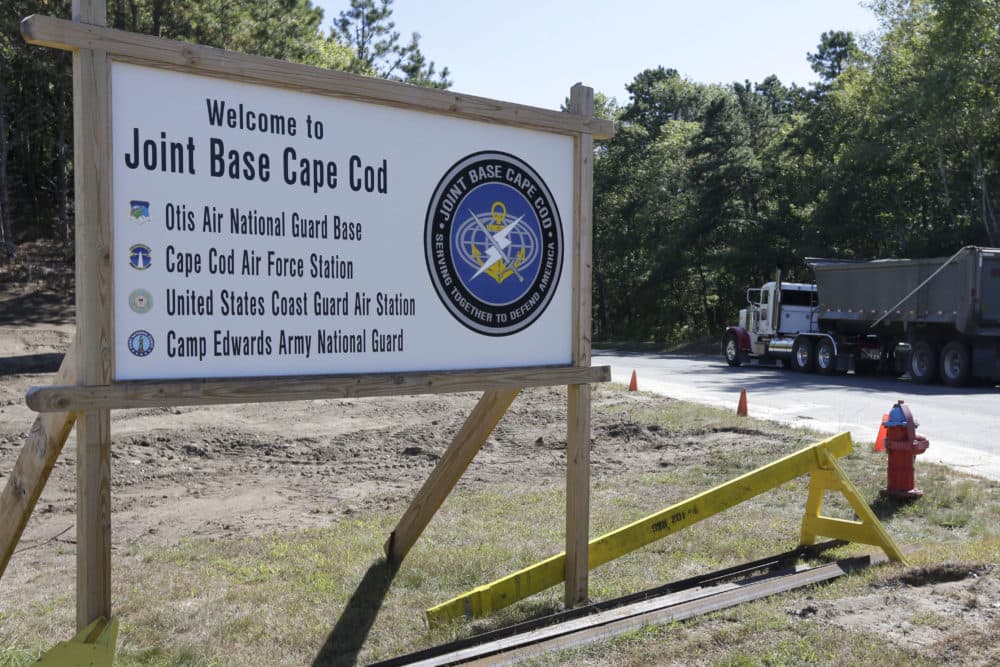Advertisement
Study: Toxic contamination at Joint Base Cape Cod could persist for centuries

So-called "forever chemicals" from a fire training site at Joint Base Cape Cod are still leaching into groundwater decades after training took place, according to a new study from Harvard researchers. The site was contaminated with PFAS chemicals in firefighting foam.
The study also finds that the slow drip of PFAS compounds through the soil into groundwater will likely continue for centuries unless it's remediated, potentially creating a long-term public health problem. The site is a known source of drinking water contamination for the nearby towns of Falmouth and Mashpee.
"The PFAS in firefighting foams is so concentrated, and the amounts used at these former fire training areas are so large, that even a small trickle into the groundwater over time is a concern," said Elsie Sunderland, a Harvard environmental chemist and senior author on the study.
The study finds that only about a quarter of the chemicals from the Joint Base Cape Cod site have moved into groundwater, even though the site hasn't been used for fire training since 1985. Because of the PFAS compounds' chemical makeup, they tend to accumulate and linger in the spongy soil where air and water mix.
"The vast majority of what was applied is still sitting right next to where it was applied," said Bridger Ruyle, the lead study author who completed the analysis as a postgraduate in Sunderland's lab.
"Really small amounts that have left the fire training area have caused this horrible downstream problem, but most of it is still waiting to be transported downstream into the lakes and into the wells."
The study reinforces concerns over the vulnerability of Cape Cod's drinking water supply to activities at Joint Base Cape Cod and the long-term costs of cleanup, said Andrew Gottlieb, executive director of the nonprofit advocacy group Association to Preserve Cape Cod. He's also concerned about a proposed machine gun range that could further contaminate groundwater at the site.
"The groundwater and land above the groundwater is already compromised by extensive pollution," he said. "The towns immediately adjacent to the base can continue to expect to be dealing with the costs associated with broad scale contamination of the aquifer from the base — in this case from PFAS — almost forever," Gottlieb said.
In a statement, the Massachusetts National Guard said it "remains dedicated to the protection of the aquifer and the environment in and around Joint Base Cape Cod, noting that the Department of Defense is currently involved in two large-scale cleanup programs at the base.
Advertisement
The statement noted that the Harvard study could help the department by "providing a more thorough evaluation of environmental impacts and help us to provide greater fidelity in assessing impacted water sources."

The Harvard researchers also measured PFAS "precursors" in the site's groundwater. These poorly understood chemicals can change into better-known PFAS compounds through chemical and microbial reactions in the soil. Most of the PFAS chemicals in firefighting foam consist of these precursors, said Ruyle, but they are not included proposed regulations or remediation plans.
"So you could imagine a scenario where you spend a lot of money doing a site investigation and remediation that's effective for the compounds that you care about," said Ruyle. "But then you go back in five years and realize you haven't gotten rid of the problem at all."
Because of this many scientists and public health advocates are urging that PFAS chemicals be regulated as a class, rather than regulating individual chemicals.
"We need to be testing more broadly," said Boston University toxicologist Wendy Heiger-Bernays, who was not involved with the Harvard study but called the findings "frightening."
"And, we need to be regulating classes of chemicals and not the individual PFAS."
In March, the U.S. Environmental Protection Agency proposed regulating six PFAS chemicals in public drinking water. The public comment period for the proposed regulations ends on May 30.
PFAS chemicals were invented in the early 20th century and used in aqueous film forming foam, or AFFF, widely used to fight fires. As a result, PFAS contamination is common near airports, fire training academies, and military bases that used AAAF for fire training drills and fighting fires. AFFF is one of the largest sources of PFAS contamination in drinking water.
A separate Harvard study released Monday found that communities with higher proportions of Black and Latino residents are more likely to be exposed to harmful levels of PFAS in their water supplies due to nearby sources of PFAS pollution, such as factories, airports, military bases and landfills.
PFAS chemicals have been linked to a number of health concerns, including increased risk of testicular and kidney cancers, high cholesterol and decreased immune function.
